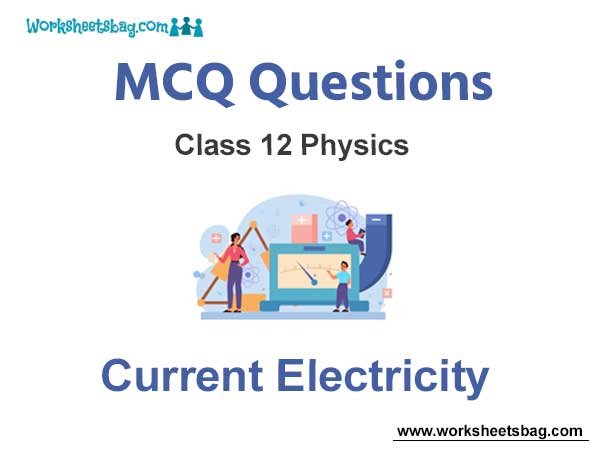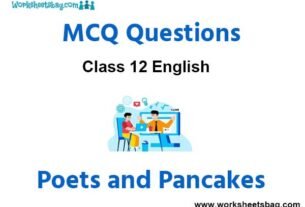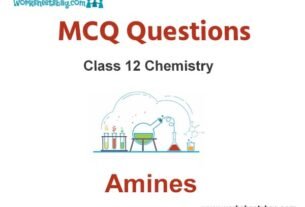Please refer to Current Electricity MCQ Questions Class 12 Physics below. These MCQ questions for Class 12 Physics with answers have been designed as per the latest NCERT, CBSE books, and syllabus issued for the current academic year. These objective questions for Current Electricity will help you to prepare for the exams and get more marks.
Current Electricity MCQ Questions Class 12 Physics
Please see solved MCQ Questions for Current Electricity in Class 12 Physics. All questions and answers have been prepared by expert faculty of standard 12 based on the latest examination guidelines.
MCQ Questions Class 12 Physics Current Electricity
Question. A charge is moving across a junction, then
(a) momentum will be conserved.
(b) momentum will not be conserved.
(c) at some places momentum will be conserved and at some other places momentum will not be conserved.
(d) none of these.
Answer
D
Question. Which of the following I-V graph represents ohmic conductors?

Answer
A
Question. The I-V characteristics shown in figure represents

(a) ohmic conductors
(b) non-ohmic conductors
(c) insulators
(d) superconductors
Answer
B
Question. Which of the following is correct for V-I graph of a good conductor?

Answer
A
Question. The resistivity of alloy manganin is
(a) Nearly independent of temperature.
(b) Increases rapidly with increase in temperature
(c) Decreases with increase in temperature.
(d) Increases rapidly with decrease in temperature.
Answer
A
Question. An electric heater is connected to the voltage supply. After few seconds, current gets its steady value then its initial current will be
(a) equal to its steady current.
(b) slightly higher than its steady current.
(c) slightly less than its steady current.
(d) zero
Answer
B
Question. In the series combination of two or more than two resistances
(a) the current through each resistance is same.
(b) the voltage through each resistance is same.
(c) neither current nor voltage through each resistance is same.
(d) both current and voltage through each resistance are same.
Answer
A
Question. Combine three resistors 5 W, 4.5 Ω and 3 Ω in such a way that the total resistance of this combination is maximum
(a) 12.5 Ω
(b) 13.5 Ω
(c) 14.5 Ω
(d) 16.5 Ω
Answer
A
Question. A cell having an emf e and internal resistance r is connected across a variable external resistance R. As the resistance R is increased, the plot of potential difference V across R is given by

Answer
B
Question. In parallel combination of n cells, we obtain
(a) more voltage
(b) more current
(c) less voltage
(d) less current
[Ans. (b)
Answer
B
Question. If n cells each of emf e and internal resistance r are connected in parallel, then the total emf and internal resistance will be
(a) ∈, r/n
(b) ∈,nr
(c) n∈, r/n
(d) n∈, nr
Answer
A
Question. In a wheat stone bridge if the battery and galvanometer are interchanged then the deflection in galvanometer will
(a) change in previous direction
(b) change in opposite direction
(c) not change
(d) none of these.
Answer
C
Question. When a metal conductor connected to left gap of a meter bridge is heated, the balancing point
(a) shifts towards right
(b) shifts towards left
(c) remains unchanged
(d) remains at zero
Answer
B
Question. In a potentiometer of 10 wires, the balance point is obtained on the 7th wire. To shift the balance oint to 9th wire, we should
(a) decrease resistance in the main circuit.
(b) increase resistance in the main circuit.
(c) decrease resistance in series with the cell whose emf is to be measured.
(d) increase resistance in series with the cell whose emf is to be determined.
Answer
D
Question. AB is a wire of potentiometer with the increase in the value of resistance R, the shift in the balance point J will be

(a) towards B
(b) towards A
(c) remains constant
(d) first towards B then back towards A.
Answer
A
Question. A current of 5 A passes through a copper conductor (resistivity =17 x 10-8 . Ω-m) of radius of cross-section 5 mm. Find the mobility of the charges, if their drift velocity is 11 10 3 . × − m/s. (2019 Main, 10 April I)
(a) 1.5 m2 / V-s
(b) 1.3 m2 / V-s
(c) 1.0 m2 / V-s
(d) 1.8 m2 / V-s
Answer
C
Question. A metal wire of resistance 3 Ω is elongated to make a uniform wire of double its previous length. This new wire is now bent and the ends joined tomake a circle. If two points on this circle make an angle 60º at the centre, the equivalent resistance between these two points will be
(a) (7/2)Ω
(b) (5/2)Ω
(c) (12/5)Ω
(d) (5/3)Ω
Answer
D
Question. In an experiment, the resistance of a material is plotted as a function of temperature (in some range). As shown in the figure, it is a straight line.

Answer
C
Question. In a conductor, if the number of conduction electrons per unit volume is 8 5 1028 . × m−3 and mean free time is 25 fs (femto second), it’s approximate resistivity is (Take, me = 91 x 10-31 . kg)
(a) 10 −7Ω-m
(b) 10 −5Ω-m
(c) 10 −6Ω-m
(d) 10 −8Ω-m
Answer
D
Question. Determine the charge on the capacitor in the following circuit

(a) 2μC
(b) 200μC
(c) 10 μC
(d) 60 μC
Answer
B
Question. A copper wire is stretched to make it 0.5% longer. The percentage change in its electrical resistance, if its volume remains unchanged is
(a) 2.0%
(b) 1.0%
(c) 0.5%
(d) 2.5%
Answer
B
Question. Space between two concentric conducting spheres of radii a and b (b > a ) is filled with a medium of resistivity r. The resistance between the two spheres will be

Answer
B
Question. A wire of resistance R is bent to form a square ABCD as shown in the figure. The effective resistance between E and C is [E is mid-point of arm CD]

Answer
A
Question. A uniform metallic wire has a resistance of 18 Ω and is bent into an equilateral triangle. Then, the resistance between any two vertices of the triangle is
(a) 12 Ω
(b) 8 Ω
(c) 2 Ω
(d) 4 Ω
Answer
D
Question. Mobility of electrons in a semiconductor is defined as the ratio of their drift velocity to the applied electric field. If for an n – type semiconductor, the density of electrons is 1019m−3 and their mobility is 16 2 . m (V-s), then the resistivity of the semiconductor (since, it is an n-type semiconductor contribution of holes is ignored) is close to
(a) 2 Ω-m
(b) 0.2 Ω-m
(c) 0.4 Ω-m
(d) 4Ω-m
Answer
C
Question. When 5V potential difference is applied across a wire of length 0.1m, the drift speed of electrons is 2 5 x 10-4 ms-1 . If the electron density in the wire is 8 10 × 28−3 m the resistivity of the material is close to
(a) 1.6 × 10-8 Wm
(b) 1.6 × 10-7 Wm
(c) 1.6 × 10-5 Wm
(d) 1.6 × 10-6 Wm
Answer
C
Question. Drift speed of electrons, when 1.5 A of current flows in a copper wire of cross-section 5 mm2 is v. If the electron density in copper is 9× 1028 / m3, the value of v in mm/s is close to (Take, charge of electron to be = 16 x 10-19 . C)
(a) 0.02
(b) 0.2
(c) 2
(d) 3
Answer
A
Question. In an aluminium (Al) bar of square cross section, a square hole is drilled and is filled with iron (Fe) as shown in the figure. The electrical resistivities of Al and Fe are 27 x 10-8. Wm and 10 x 10-7. Wm, respectively. The electrical resistance between the two faces P and Q of the composite bar is

Answer
B
Question. Consider a thin square sheet of side L and thickness t, made of a material of resistivity r. The resistance between two opposite faces, shown by the shaded areas in the figure is

(a) directly proportional to L
(b) directly proportional to t
(c) independent of L
(d) independent of t
Answer
C
Question. A steady current flows in a metallic conductor of non-uniform cross-section. The quantity/quantities constant along the length of the conductor is/are.
(a) current, electric field and drift speed
(b) drift speed only
(c) current and drift speed
(d) current only
Answer
D
Question. Six equal resistances are connected between points P,Q and R as shown in the figure. Then, the net resistance will be maximum between

(a) P and Q
(b) Q and R
(c) P and R
(d) any two points
Answer
A
Question. The effective resistance between points P and Q of the electrical circuit shown in the figure is

Answer
A
Question. Read the following statements carefully (1993, 2M) Y : The resistivity of semiconductor decreases with increase of temperature. Z : In a conducting solid, the rate of collisions between free electrons and ions increases with increase of temperature.
Select the correct statement (s) from the following
(a) Y is true but Z is false
(b) Y is false but Z is true\
(c) Both Y and Z are true
(d) Y is true and Z is the correct reason for Y
Answer
C
Question. A piece of copper and another of germanium are cooled from room temperature to 80 K. The resistance of
(a) each of them increases
(b) each of them decreases
(c) copper increases and germanium decreases
(d) copper decreases and germanium increases
Answer
D
Question. In the circuit shown, the potential difference between A and B is

(a) 3 V
(b) 1 V
(c) 6 V
(d) 2 V
Answer
D
Question. To verify Ohm’s law, a student connects the voltmeter across the battery as shown in the figure. The measured voltage is plotted as a function of the current and the following graph is obtained

If V0 is almost zero, then identify the correct statement.
(a) The emf of the battery is 1.5 V and its internal resistance is 1.5 Ω
(b) The value of the resistance R is 1.5 Ω
(c) The potential difference across the battery is 1.5 V when it sends a current of 1000 mA
(d) The emf of the battery is 1.5Vand the value of R is 1.5 Ω
Answer
A
Question. In the given circuit, an ideal voltmeter connected across the 10 Ω resistance reads 2 V. The internal resistance r, of each cell is

(a) 1.5 Ω
(b) 0.5 Ω
(c) 1 Ω
(d) 0 Ω
Answer
B
Question. In the figure shown, what is the current (in ampere) drawn from the battery?
You are given : R1 = 15 Ω, R2 = 10 Ω, R3 = 20 Ω, R4 = 5 Ω, R5 = 25 Ω, R6 = 30 Ω, E = 15V

(a) 13/24
(b) 7/18
(c) 20/3
(d) 9/32
Answer
D
Question. For the circuit shown with R1 = 1.0Ω, R2 = 2.0Ω, E1 = 2 V and E2 = E3 = 4 V, the potential difference between the points a and b is approximately (in volt)

(a) 2.7
(b) 2.3
(c) 3.7
(d) 3.3
Answer
D
Question. In a Wheatstone bridge (see figure), resistances P and Q are approximately equal. When R = 400 Ω, the bridge is balanced. On interchanging P and Q , the value of R for balance is 405 Ω. The value of X is close to

(a) 404.5 Ω
(b) 401.5 Ω
(c) 402.5 Ω
(d) 403.5 Ω
Answer
C
Question. In the given circuit diagram, the currents I1 = − 0.3 A, I4 = 0.8 A and I5 = 0.4 A, are flowing as shown. The currents I2, I3 and I6 respectively, are

(a) 1.1 A, 0.4 A, 0.4 A
(b) 1.1 A, − 0 4 . A,0.4A
(c) 0.4 A, 1.1 A, 0.4 A
(d) − 0 4 . A, 0.4 A,1.1A
Answer
A
Question. In the circuit shown in the figure, the current through

(a) the 3 Ω resistor is 0.50 A
(b) the 3 Ω resistor is 0.25 A
(c) the 4 Ω resistor is 0.50 A
(d) the 4 Ω resistor is 0.25 A
Answer
D
Question. In the given circuit, the cells have zero internal resistance. The currents (in Ampere) passing through resistances R1 and R2 respectively are

(a) 0.5, 0
(b) 1, 2
(c) 2, 2
(d) 0, 1
Answer
A
Question. In the given circuit, the internal resistance of the 18 V cell is negligible. If R1 = 400 Ω, R3 = 100 Ω and R4 = 500 Ω and the reading of an ideal voltmeter across R4 is 5 V, then the value of R2 will be

a) 550 Ω
(b) 230 Ω
(c) 300 Ω
(d) 450 Ω
Answer
C
Question. When the switch S in the circuit shown is closed, then the value of current i will be

(a) 4A
(b) 3A
(c) 2A
(d) 5A
Answer
D
Question. Two batteries with emf 12 V and 13 V are connected in parallel across a load resistor of 10 Ω. The internal resistances of the two batteries are 1Ω and 2 Ω, respectively. The voltage across the load lies between
(a) 11.7 V and 11.8 V
(b) 11.6 V and 11.7 V
(c) 11.5 V and 11.6 V
(d) 11.4 V and 11.5 V
Answer
C
Question. In the below circuit, the current in each resistance is

(a) 0.25 A
(b) 0.5 A
(c) 0 A
(d) 1 A
Answer
C
Question. In the circuit shown below, the current in the 1Ω resistor is

(a) 1.3 A, from P to Q
(b) 0.13 A, from Q to P
(c) 0 A
(d) 0.13 A, from P to Q
Answer
B
Question. Find out the value of current through 2 Ω resistance for the given circuit.

(a) 5 A
(b) 2 A
(c) zero
(d) 4 A
Answer
C
Question. In the given circuit, it is observed that the current I is independent of the value of the resistance R6. Then, the resistance values must satisfy

Answer
C
Question. In the circuit shown P ¹ R, the reading of galvanometer is same with switch S open or closed. Then

(a) IR = IG
(b) IF = IG
(c) IQ = IG
(d) IQ = IR
Answer
A
Question. A battery of internal resistance 4 Ω is connected to the network of resistances as shown in figure. In order that the maximum power can be delivered to the network, the value of R in Ω should be

(a) 4/9
(b) 2
(c) 8/3
(d) 18
Answer
B
Read the two statements Assertion (A) and Reason (R) carefully to mark the correct option out of the options given below:
(a) Assertion (A) and Reason (R) both are correct statements and Reason is correct explanation for Assertion.
(b) Assertion (A) and Reason (R) both are correct statements but Reason is not correct explanation for Assertion.
(c) Assertion (A) is correct statement but Reason (R) is wrong statement.
(d) Assertion (A) is wrong statement but Reason (R) is correct statement.
Question. Assertion: The drift velocity of electrons in a metallic wire will decrease, if the temperature of the wire is increased.
Reason: On increasing temperature, conductance of metallic wire decrease.
Answer
B
Question. Assertion: Chemical reactions involved in primary cells are irreversible and in secondary cells are reversible.
Reason: Primary cells can be recharged, but secondary cells cannot be recharged.
Answer
C
Question. Assertion: It the length of the conductor is doubled, the drift velocity will become half of the original value (keeping potential) difference unchanged).
Reason: At constant potential difference, drift velocity is inversely proportional to the length of the conductor.
Answer
A
Question. Assertion: Material used in the construction of a standard resistance is constantan or manganin.
Reason: Temperature coefficient of constantan is very small.
Answer
A
Question. Assertion: The 200 W bulbs glows with more brightness than 100 W bulbs.
Reason: A 100 watt bulb has more resistance than a 200 W bulb.
Answer
A
Question. Assertion: Fuse wire must have high resistance and low melting point.
Reason: Fuse is used for small current flow only.
Answer
C
Question. Assertion: Two electric bulbs of 30 Watt and 100 watt are given. When connected in series 50 watt bulb glows more but when connected in parallel 100 watt bulb glows more.
Reason: In series combination, power is directly proportional to the resistance of circuit. But in parallel combination, power is inversely proportional to the resistance of the circuit.
Answer
A
Question. Assertion: It is advantageous to transmit electric power at high voltage.
Reason: High voltage implies high current.
Answer
C
Question. Assertion: Though the same current flows through the line wires and the filament of the bulb but heat produced in the filament is much higher than that in line wires.
Reason: The filament of bulbs is made of a material of high resistance and high melting point.
Answer
B
Question. Assertion: The current in a wire is due to flow of free electrons in a definite direction.
Reason: A current carrying wire should have non-zero charge.
Answer
C


